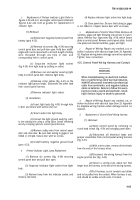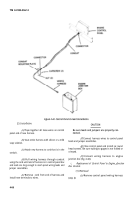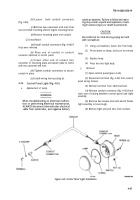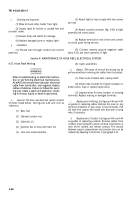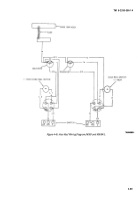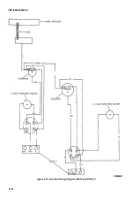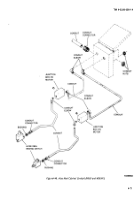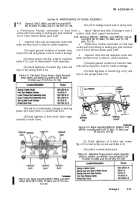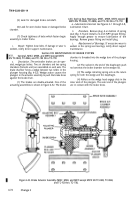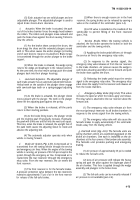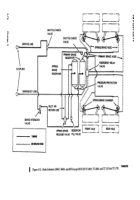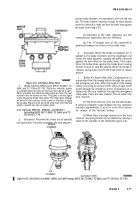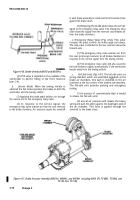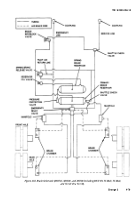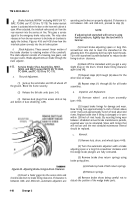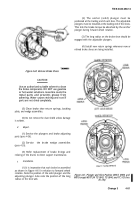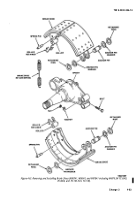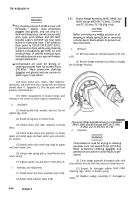TM-9-2330-356-14
SEMITRAILER, TANK: 5000 GALLON, BULK HAUL, SELF LOAD/UNLOAD M967 AND M967A1; SEMITRAILER, TANK: 5000 GALLON, FUEL DISPENSING, AUTOMOTIVE M969 AND M969A1; SEMITRAILER, TANK: 5000 GALLON, FUEL DISPENSING, UNDER/OVERWING AIRCRAFT M970 AND M970A1
TECHNICAL MANUAL; OPERATOR’S, UNIT, DIRECT SUPPORT, AND GENERAL SUPPORT MAINTENANCE MANUAL
OCTOBER 1990
TM-9-2330-356-14 - Page 211 of 528
TM 9-2330-356-14
(5) Each actuator has one solid plunger and one
(2) When there is enough reserve air in the front
adjustable plunger. The adjustable plunger is used to
reservoir, the spring brakes can be released by opening a
adjust brake shoe-to-drum clearance.
valve on the roadside of the semitrailer (para 2-4).
b.
Actuation.
When the brake is actuated, the push
rod of the brake chamber forces the wedge head between
the rollers. The rollers and plungers move outward and
push the brake shoes against the drum causing friction to
slow the vehicle.
(1) As the brake shoes contact the drum, the
drum drags the shoes and the extended plungers around
with it. This action causes the anchor plunger (at trailing
end of each shoe) to reseat on its abutment. Brake torque
is transmitted through the anchor plunger to the brake
support.
(2) When the brake is released, the wedge spring
returns the wedge and diaphragm to the released position.
At the same time, the shoe return springs push the raised
plungers back into their plunger housings.
c.
Automatic Adjusters. The
adjustable plunger of
each brake actuator has an automatic adjustment feature.
Helical teeth on the outside of the plunger sleeve engage
with saw-tooth-type teeth on a spring-engaged adjusting
pawl.
(1) As the brake is actuated, the plunger sleeve
moves outward with the plunger. The teeth on the plunger
sleeve lift the adjusting pawl against the spring.
(2) When the brake is released, all the parts
return to their starting positions.
(3) As the brake lining wears. the plunger stroke
and the resulting pawl lift gradually increases. Eventually,
the pawl will climb over and fall into the next tooth space.
This time, when the brake is released, the upright face of
the pawl teeth causes the adjusting sleeve to rotate and
advance the adjusting bolt.
(4) The automatic adjuster operates only when
vehicle is moving forward.
d.
Brake Air System (Fig. 4-53).
Compressed air is
transmitted from the towing vehicle through the service
and emergency air lines. When the engine of the towing
vehicle is running, air pressure of 90-120 psi is kept in the
system through the emergency air line. Compressed air is
routed into the rear reservoir through the emergency
relay valve. From the rear reservoir, the air enters the
front reservoir.
(1) The front reservoir is for the fail-safe brakes.
A pressure protection valve between the two reservoirs
maintains approximately 75 psi of air in the front reservoir
for release of the fail-safe brakes.
(3) A fill valve is installed on the roadside of the
semitrailer to permit filling of the front reservoir
(para 2-4a).
e.
Service
Brake.
When the towing vehicle is
attached, the foot brake operates the brakes on both the
semitrailer and the towing vehicle.
(1) Applying the brake pedal delivers air through
the service air line to the emergency relay valve.
(2) In response to the service signal, the
emergency relay valve releases air from the rear reservoir
to the brake chambers. Air pressure causes the wedge in
each brake actuating assembly to move forward and push
the brake shoes against the drum.
(3) Releasing the brake pedal stops the service
signal to the emergency relay valve. The emergency relay
valve closes the supply from the reservoir and releases air
from the brake chambers.
f.
Emergency Relay Valve (Fig.
4-54). This valve
increases the speed at which the brakes apply and release.
The relay valve is attached to the rear reservoir above the
forward axle.
(1) The emergency relay valve releases air from
the rear (primary) reservoir to all brake chambers in
response to the service signal from the towing vehicle.
(2) The emergency relay valve will also cause the
fail-safe brakes to apply automatically if the semitrailer
breaks away from the towing vehicle.
g. Fail-Safe Units (Fig. 4-55).
The fail-safe units are
spring chambers which are assembled piggyback on the
brake air chambers. One each is installed on the air
chambers at the four comers of the tandem axle assembly.
The fail-safe unit provides parking and emergency
braking.
(1) Air pressure of approximately 65 psi is needed
to release the fail-safe units.
(2) Loss of air pressure will release the heavy
spring and push the piston against the diaphragm plate of
the air chamber. This force is applied through the wedge
assembly and plungers to the brake shoes.
(3) The fail-safe units can be manually released if
air pressure is not available (para 2-4).
4-75
Back to Top

